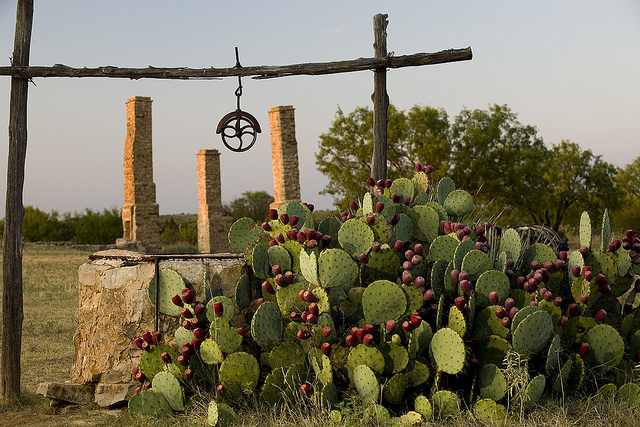The Rugged Beauty of Fort Phantom is Rich in History.
A rustic romance and a hint of mystery still cling to more than a dozen tall stone chimneys which tower over Fort Phantom Hill near Abilene. Like the soldiers who once guarded this parched patch of West Texas soil, the lonely chimneys stand over the rugged beauty of native cacti, wildflowers and mesquite trees.
The chimneys are a rock reminder of the colorful early days of Texas history, when Native Americans from the Comanche tribe still roamed the area, and U.S. Infantry troops struggled to create an outpost to protect the westward-moving frontier of Texas settlement.
 Modern day visitors to Fort Phantom Hill can still get a feel for what life must have been like here in the 1850s as people tried to tame the unforgiving West Texas landscape. It seems the wisdom of General Persifor F. Smith’s choice of this site for what was originally known as “The Post on the Clear Fork of the Brazos River” was disputed from the very beginning, especially by Major John Joseph Abercrombie. The major was a West Point graduate who commanded the Post on the Clear Fork from the time of its establishment on November 14, 1851, until April 27, 1852, according to A History of Fort Phantom Hill, The Post on the Clear Fork of the Brazos River, Jones County, Texas (prepared by Martha Doty Freeman in May 1999 for The Fort Phantom Foundation).
Modern day visitors to Fort Phantom Hill can still get a feel for what life must have been like here in the 1850s as people tried to tame the unforgiving West Texas landscape. It seems the wisdom of General Persifor F. Smith’s choice of this site for what was originally known as “The Post on the Clear Fork of the Brazos River” was disputed from the very beginning, especially by Major John Joseph Abercrombie. The major was a West Point graduate who commanded the Post on the Clear Fork from the time of its establishment on November 14, 1851, until April 27, 1852, according to A History of Fort Phantom Hill, The Post on the Clear Fork of the Brazos River, Jones County, Texas (prepared by Martha Doty Freeman in May 1999 for The Fort Phantom Foundation).
Lieutenant Clinton Lear, the post’s quartermaster, even went so far as to assert that he could not imagine “that God ever intended white man to occupy such a barren waste” as was found at Phantom Hill. (Chapter 5, pages 65-67, and 70-73)
All arguments notwithstanding, the post was indeed established, and by 1853, it was transformed into a well-organized and thoroughly developed post. However, conditions continued to be difficult for people at the fort, and in November 1853, approval was given for the military to abandon the fort. Shortly after the troops left, fire destroyed most of the log walls and thatch roofs of the buildings that made up this large and complex five-company post on the Texas Frontier. However, several stone buildings, stone chimneys, and the stone building foundations remain intact today. A watercolor portrait of the original fort shows Fort Phantom Hill as it was before the fire.
In 1858, the property was reoccupied as a way station on the Southern Overland Mail route, and the Butterfield Stagecoach set up a stop at the abandoned fort. Fort Phantom Hill was used again during the Civil War by the Confederacy’s Frontier Battalion, and in 1871, it became a sub-post of Fort Griffin (near Albany, Texas) and was used by troops engaged in Indian campaigns.
 After 1875, a town grew up around the ruins of Fort Phantom Hill. The location functioned first as a buying and shipping point for buffalo hides and eventually as a town of more than 500 residents. Census records in 1880 show more than 545 people living at the fort, which had a hotel and the staples of most West Texas towns.
After 1875, a town grew up around the ruins of Fort Phantom Hill. The location functioned first as a buying and shipping point for buffalo hides and eventually as a town of more than 500 residents. Census records in 1880 show more than 545 people living at the fort, which had a hotel and the staples of most West Texas towns.
Fort Phantom Hill also served briefly as the Jones County seat, although residents later moved it to the community of Anson. By the 1890s, Fort Phantom Hill was largely abandoned.
The Fort Phantom Hill property has been owned by the family of Abilenian John Guitar since he purchased it in 1928. Mr. Guitar’s grandson, Jim Alexander of Abilene, purchased the property in 1969. In 1997, Mr. Alexander deeded the property to the Fort Phantom Foundation to help ensure its long-term preservation and to make it more accessible to the public.
Today, Fort Phantom Hill is one of the most pristine historic sites in Texas. Besides the stone chimneys, other remnants of the developed fort remain for visitors to explore at the 38-acre site. These include an intact stone powder magazine, a stone guardhouse, and an almost-intact commissary or warehouse.
View our Photo Galleries
Note to historians:
A History of Fort Phantom Hill, The Post on the Clear Fork of the Brazos River, Jones County, Texas (prepared by Martha Doty Freeman in May 1999 for the Fort Phantom Foundation) is available for inspection at the Abilene Public Library, complete with reproductions of historic photos, drawings, and other documents.

